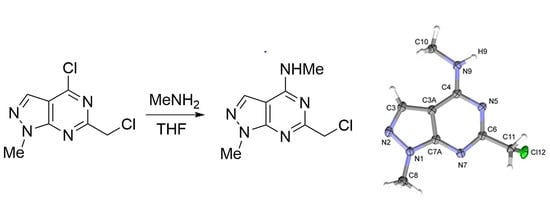6-(Chloromethyl)-N,1-dimethyl-1H-pyrazolo[3,4-d]pyrimidin-4-amine
Abstract
:1. Introduction
2. Results and Discussion
3. Materials and Methods
Supplementary Materials
Author Contributions
Funding
Institutional Review Board Statement
Informed Consent Statement
Data Availability Statement
Acknowledgments
Conflicts of Interest
Sample Availability
References
- Quintela, J.M.; Peinador, C.; Lez, L.G.; Devesa, I.; Ferrandiz, M.L.; Alcaraz, M.J.; Riguera, R. Synthesis and evaluation of trans 3,4-cyclopropyl L-arginine analogues as isoform selective inhibitors of nitric oxide synthase. Bioorg. Med. Chem. 2003, 11, 863–868. [Google Scholar] [CrossRef]
- Ahmed, O.M.; Mohamed, M.A.; Ahmed, R.R.; Ahmed, S.A. Synthesis and anti-tumor activities of some new pyridines and pyrazolo[1,5-a]pyrimidines. Eur. J. Med. Chem. 2009, 44, 3519–3523. [Google Scholar] [CrossRef] [PubMed]
- Holla, B.S.; Mahalinga, M.; Karthikeyan, M.S.; Akberali, P.M.; Shetty, N.S. Synthesis of some novel pyrazolo[3,4-d]pyrimidine derivatives as potential antimicrobial agents. Bioorg. Med. Chem. 2006, 14, 2040–2047. [Google Scholar] [CrossRef]
- Elnagdi, M.H.; Al-Awadi, N.; Abdelhamid, I.A. Bicyclic 5-6 Systems: Other Four Heteroatoms 2:2. In Comprehensive Heterocyclic Chemistry III; Katritzky, A.R., Ramsden, C.A., Scriven, E.F.V., Taylor, R.J.K., Eds.; Elsevier: Oxford, UK, 2008; Volume 10, pp. 600–658. [Google Scholar] [CrossRef]
- Devarakonda, M.; Doonaboina, R.; Vanga, S.; Vemu, J.; Boni, S.; Mailavaram, R.P. Synthesis of novel 2-alkyl-4-substituted-amino-pyrazolo[3,4-d]pyrimidines as new leads for anti-bacterial and anti-cancer activity. Med. Chem. Res. 2013, 22, 1090–1101. [Google Scholar] [CrossRef]
- Ogurtsov, V.A.; Rakitin, O.A. 4-Chloro-6-(chloromethyl)-1-methyl-1H-pyrazolo[3,4-d]pyrimidine. Molbank 2021, 2021, M1253. [Google Scholar] [CrossRef]
- CrysAlisPro. Version 1.171.41.106a. In Rigaku Oxford Diffraction; Rigaku Corporation: Oxford, UK, 2021. [Google Scholar]
- Sheldrick, G.M. SHELXT—Integrated space-group and crystal-structure determination. Acta Cryst. 2015, A71, 3–8. [Google Scholar] [CrossRef] [PubMed] [Green Version]
- Sheldrick, G.M. Crystal structure refinement with SHELXL. Acta Cryst. 2015, C71, 3–8. [Google Scholar] [CrossRef]
- Dolomanov, O.V.; Bourhis, L.J.; Gildea, R.J.; Howard, J.A.K.; Puschmann, H. OLEX2: A complete structure solution, refinement and analysis program. J. Appl. Cryst. 2009, 42, 229–341. [Google Scholar] [CrossRef]


| Empirical Formula | C8H10ClN5 |
|---|---|
| Formula weight | 211.66 |
| Temperature | 100.00(10) K |
| Wavelength | 1.54184 Å |
| Crystal system | Monoclinic |
| Space group | P21/c |
| Unit cell dimensions | a = 17.06395(16) Å b = 4.24549(4) Å c = 26.1022(3) Å |
| Volume | 1883.78(3) Å3 |
| Z | 8 |
| Density (calculated) | 1.493 g/cm3 |
| Absorption coefficient | 3.326 mm−1 |
| F(000) | 880 |
| Crystal size | 0.4 × 0.04 × 0.03 mm3 |
| Theta range for data collection | 2.599 to 79.469° |
| Index ranges | −21 <= h <=21, −4 <= k <= 5, −33 <= l <= 32 |
| Reflections collected | 22312 |
| Independent reflections | 4107 [R(int) = 0.0309] |
| Completeness to theta = 67.684° | 100.0% |
| Absorption correction | Semi-empirical from equivalents |
| Max. and min. transmission | 1.00000 and 0.69959 |
| Refinement method | Full-matrix least-squares on F2 |
| Data/restraints/parameters | 4107/0/265 |
| Goodness-of-fit on F2 | 1.045 |
| Final R indices [I > 2sigma(I)] | R1 = 0.0382, wR2 = 0.0970 |
| R indices (all data) | R1 = 0.0399, wR2 = 0.0982 |
| Largest diff. peak and hole | 0.290 and −0.354 e.Å−3 |
Publisher’s Note: MDPI stays neutral with regard to jurisdictional claims in published maps and institutional affiliations. |
© 2021 by the authors. Licensee MDPI, Basel, Switzerland. This article is an open access article distributed under the terms and conditions of the Creative Commons Attribution (CC BY) license (https://creativecommons.org/licenses/by/4.0/).
Share and Cite
Ogurtsov, V.A.; Rakitin, O.A. 6-(Chloromethyl)-N,1-dimethyl-1H-pyrazolo[3,4-d]pyrimidin-4-amine. Molbank 2021, 2021, M1294. https://doi.org/10.3390/M1294
Ogurtsov VA, Rakitin OA. 6-(Chloromethyl)-N,1-dimethyl-1H-pyrazolo[3,4-d]pyrimidin-4-amine. Molbank. 2021; 2021(4):M1294. https://doi.org/10.3390/M1294
Chicago/Turabian StyleOgurtsov, Vladimir A., and Oleg A. Rakitin. 2021. "6-(Chloromethyl)-N,1-dimethyl-1H-pyrazolo[3,4-d]pyrimidin-4-amine" Molbank 2021, no. 4: M1294. https://doi.org/10.3390/M1294
APA StyleOgurtsov, V. A., & Rakitin, O. A. (2021). 6-(Chloromethyl)-N,1-dimethyl-1H-pyrazolo[3,4-d]pyrimidin-4-amine. Molbank, 2021(4), M1294. https://doi.org/10.3390/M1294








